Depends on the photo. I've seen iPhone 13 Pro Max take much better pictures, I've seen S22 take much better pictures. It's hit and miss between the two.Flagship Samsung phone currently takes better pictures.
Got a tip for us?
Let us know
Become a MacRumors Supporter for $50/year with no ads, ability to filter front page stories, and private forums.
Camera Comparison: iPhone 14 Pro Max vs. iPhone 13 Pro Max
- Thread starter MacRumors
- Start date
- Sort by reaction score
You are using an out of date browser. It may not display this or other websites correctly.
You should upgrade or use an alternative browser.
You should upgrade or use an alternative browser.
I think the pixel binning algorithms in the 14 Pro need further optimization by Apple. Both the color science and the HDR are quite inconsistent. Hopefully this will get better as iOS updates move along. I find that it even struggles to show such improvements versus the $400 Pixel 6a 12.2MP with peasant 1.4µm pixel size:
Actually, the iPhone's sensor is much bigger here than the S22 Ultra's. You are confusing megapixels and sensor size.Don't think so, but the differences between the flagships over the past several years have been minuscule. Even with a sensor over 2x larger, the Samsung still doesn't edge out the iPhone in detail.
On such a small sensor cramming as many megapixels as you can is a very bad idea, Samsung is playing the numbers marketing game here.
Ah yeah that was my poor wording, will fix in original post.Actually, the iPhone's sensor is much bigger here than the S22 Ultra's. You are confusing megapixels and sensor size.
On such a small sensor cramming as many megapixels as you can is a very bad idea, Samsung is playing the numbers marketing game here.
Thing is though, the pixel binning allows for a higher degree of resolution detail to feed into all of the post-processing software, but it still comes out short of the iPhone.
And trust me, everyone (yes, all) will not be able to tell the difference when it comes to a blind test. Not even the person holding a 5D Mark series camera.
Definite improvements but with file size so large, will your average users ever use proRAW to receive the benefits of 48MP?
Discussing a “48MP lens” in the first paragraph of a camera article never inspires confidence.
The average user will think that it shoots 48MP photos out of the box due to Apple's marketing when in reality it's binning down to the regular 12MP.Definite improvements but with file size so large, will your average users ever use proRAW to receive the benefits of 48MP?
So the average user won't ever use it consciously or know what ProRAW even means.
A few things I noticed since upgrading from an iPhone 11 Pro Max:
The ultra wide lens does better in night mode.
The 3X zoom is welcomed, most of my photos are taken in that mode.
Obviously the screen is smaller now and several apps are crippled by the smaller screen in zoom mode.
Really don't notice that much improvement at 120 Hz so I turned that off.
App performance is almost identical to my 11.
Battery life is significantly less.
Start up time is faster by 4x.
5G can be a little bit faster than LTE than my rural location.
Cellular is working a little better where iOS 15 on my 11 I would have to toggle that several times a day to regain access.
Less screen dimming than my 11, thermals are definitely improved but as soon as I put it on my car Qi charger is it dims almost immediately.
Dictation is even more inaccurate than ever.
Always on is a nice gimmick but doesn't really have real world application yet.
There seems to be a bug with Apple Pay and certain debit cards coming up with errors saying the expiration date is incorrect even after deleting and re-adding cards.
GPS is still wonky.
Even with 6 GB of RAM apps reload every time I switch to them.
The new button locations are a bother, either the volume is up all the way or I take all these screen snapshot or Siri is waiting for me to say something.
Also noticed that when I pull it out of my pocket it's always in customize mode on the lock screen, it would be better if they had a two finger gesture to enter that mode.
Is it just me or every time I swipe up on my 14 Pro it always misinterpreted it as a swipe left so I have to swipe up on the side of the screen so it correctly registers.
What? No live wallpaper on iOS 16?
The ultra wide lens does better in night mode.
The 3X zoom is welcomed, most of my photos are taken in that mode.
Obviously the screen is smaller now and several apps are crippled by the smaller screen in zoom mode.
Really don't notice that much improvement at 120 Hz so I turned that off.
App performance is almost identical to my 11.
Battery life is significantly less.
Start up time is faster by 4x.
5G can be a little bit faster than LTE than my rural location.
Cellular is working a little better where iOS 15 on my 11 I would have to toggle that several times a day to regain access.
Less screen dimming than my 11, thermals are definitely improved but as soon as I put it on my car Qi charger is it dims almost immediately.
Dictation is even more inaccurate than ever.
Always on is a nice gimmick but doesn't really have real world application yet.
There seems to be a bug with Apple Pay and certain debit cards coming up with errors saying the expiration date is incorrect even after deleting and re-adding cards.
GPS is still wonky.
Even with 6 GB of RAM apps reload every time I switch to them.
The new button locations are a bother, either the volume is up all the way or I take all these screen snapshot or Siri is waiting for me to say something.
Also noticed that when I pull it out of my pocket it's always in customize mode on the lock screen, it would be better if they had a two finger gesture to enter that mode.
Is it just me or every time I swipe up on my 14 Pro it always misinterpreted it as a swipe left so I have to swipe up on the side of the screen so it correctly registers.
What? No live wallpaper on iOS 16?
Last edited:
Imo night mode was the last huge jump in iphone cameras (previously was smart HDR). Anything after that is more icing on the cake. As an iphone 7+ user, anything will be an improvement for me 🤣
Not sure if this was done with ProRAW on both models. If not, might be a better comparison. Isn’t there a lot of automatic processing done when NOT using ProRAW? Probably why the photos from the 14 appear darker than the 13.
What about the file size of photos taken from the two respective cameras? Presumably the 14's are going to be considerably larger and are going to fill up its storage much more quickly?
I'm a Verizon customer in NYC upgraded from 13 PM to 14 PM and the new phone works much better.Follow up comparison. Verizon iPhone 13 Pro Max = no drop calls. Verizon iPhone 14 pro max = prolly gonna drop this call.
You should call Verizon tech support ask to speak with 2nd tier support. It may be issues with your towers.
What issues were you having on the 13PM?I'm a Verizon customer in NYC upgraded from 13 PM to 14 PM and the new phone works much better.
You should call Verizon tech support ask to speak with 2nd tier support. It may be issues with your towers.
I can't imagine there being a big difference when I'm using a XS with a "crappy" Intel modem in Germany and getting 3-4 bars most of the time lol.
Maybe this is a US thing where cellular reception is spotty even in urban regions like NYC.
Hmmmm....in most of those photos, I prefer the 12MP or the 13 Pro Max
I totally agree not a big fan of the pics from the 14 pro max can’t see the need for an upgrade who want to spend hrs in software adjusting there pics because the have 48mp. Not me.Hmmmm....in most of those photos, I prefer the 12MP or the 13 Pro Max
That's confirmed that my choice to stick with my 13PM was the right one for me. I take images and mostly keep and view them on my iPhone, or send to others via WhatsApp, which kills quality anyways. I'm happy to stick with my handset for another year and see what the iPhone 15 brings. The changes from this year just aren't enough for me......but something like a periscope lens would be a change I would see and use more then a MP bump....
this photo you took is AMAZING! I'd love to be able to download a full version to use as a wallpaper. Do you post on any photo forums or anything like that?View attachment 2083722
I took this using proraw at 48mp and edited with lightroom and back to jpg and the detail is epic, I’m a photographer using canon 5D mark iv and I’m so impressed, I do wish there was an option to take a raw and normal one at the same time like on dslr
I recorded a 4 minute video at 4K 60fps which was beautiful and showed none of the jagged walking as I was recording. The video size was 1.79GB, as expected, with Dolby Vision.
Everyone
The iPhone 14 Pro and Pro Max introduce some major improvements in camera technology, adding a 48-megapixel lens and low-light improvements across all lenses with the new Photonic Engine. We've spent the last week working on an in-depth comparison that pits the new iPhone 14 Pro Max against the prior-generation iPhone 13 Pro Max to see just how much better the iPhone 14 Pro Max can be.
Subscribe to the MacRumors YouTube channel for more videos.
Though there's a 48-megapixel lens, the iPhone 14 Pro models are using pixel binning to combine four pixels into one, resulting in a standard 12-megapixel photo unless 48-megapixel images are enabled through the ProRAW toggle. When comparing a 12-megapixel image from the iPhone 14 Pro Max to a 12-megapixel image from the iPhone 13 Pro Max, there's not an immediate difference in quality, especially when lighting is ideal.
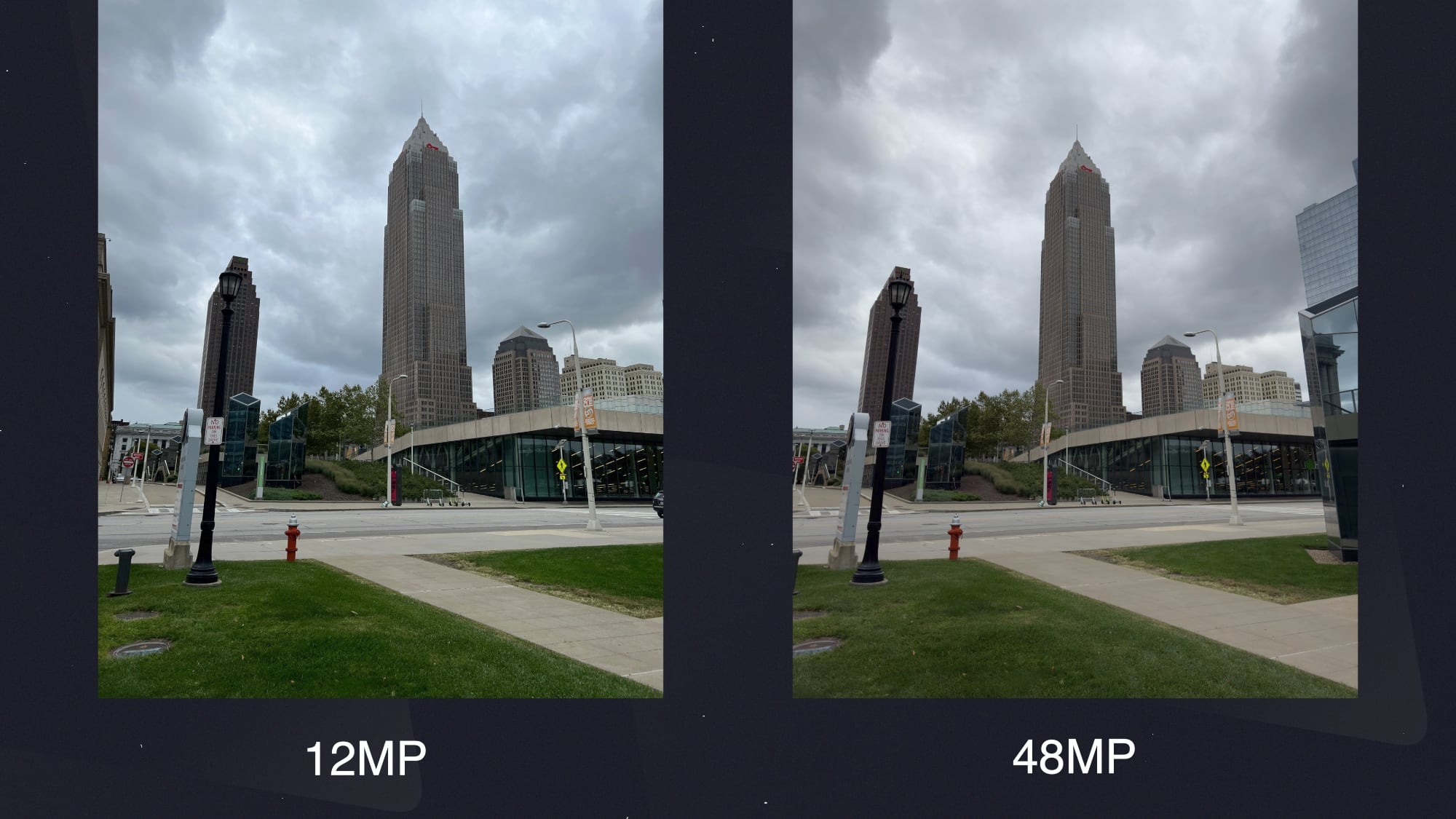
You will see some improvements in shadows and highlights for improved HDR, and the colors can be more vibrant on the iPhone 14 Pro Max, but it's a subtle difference in most cases.
Where you'll notice the biggest upgrade is turning on ProRAW for those higher quality 48-megapixel images. There is so much more detail in the 48-megapixel image compared to the 12-megapixel image from the iPhone 13 Pro Max, but file size is a major downside. 48-megapixel images can be over 60MB in size, which will quickly eat up your iPhone storage. Still, if you want to take a special photo in the highest quality, toggle on that ProRAW option and you'll see notable improvements over what you can get from the iPhone 13 Pro Max.
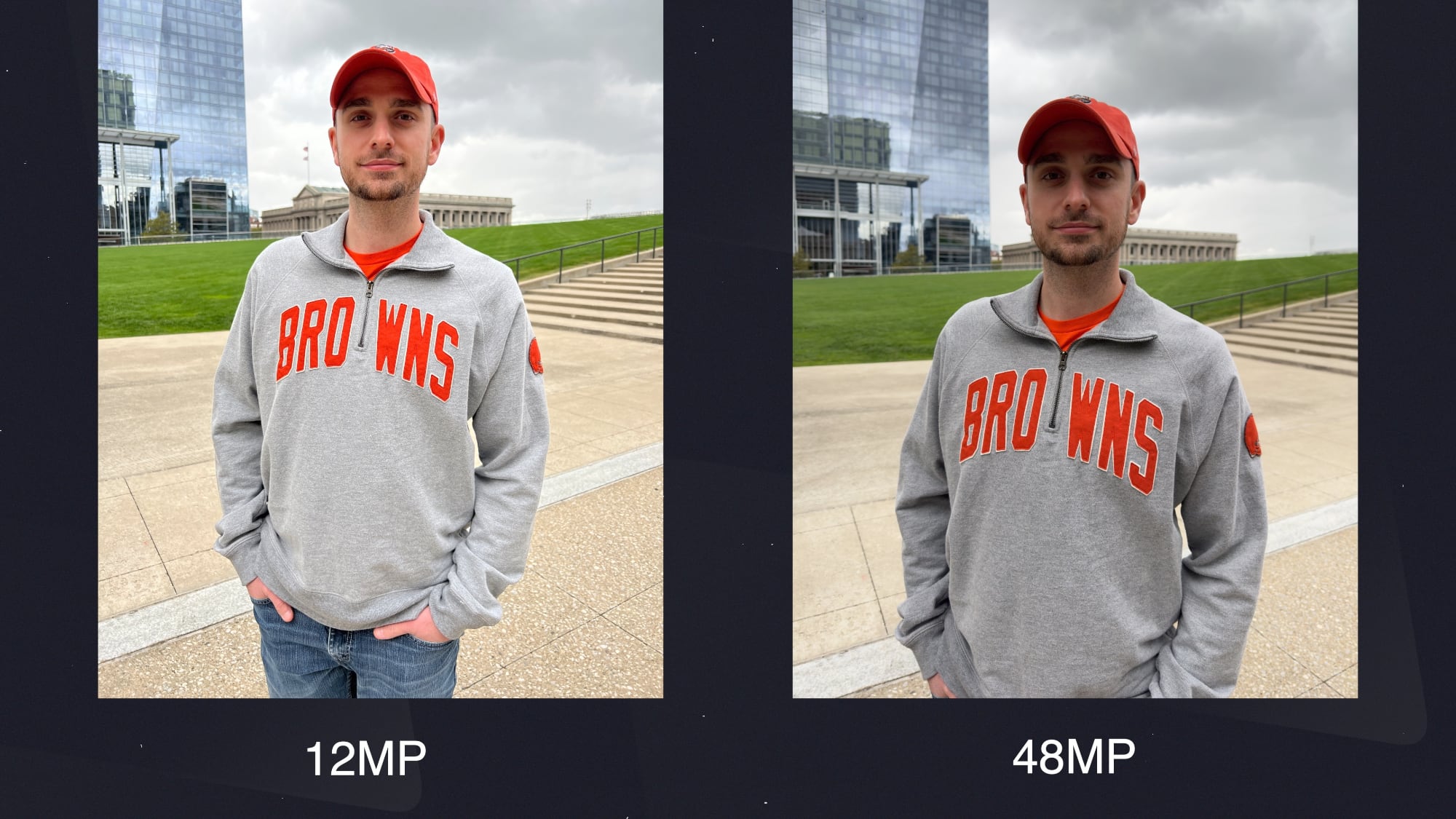
Apple is using the 48-megapixel camera for a new 2x telephoto option, which crops in to the image from the full resolution. This adds a whole new focal length to the iPhone 14 Pro models, with the iPhone 13 Pro models limited to 3x telephoto. 2x telephoto is a great length for portraits or if you just want to zoom in a bit, and because it's the main camera, the quality is better than you get with the telephoto lens even with the crop.
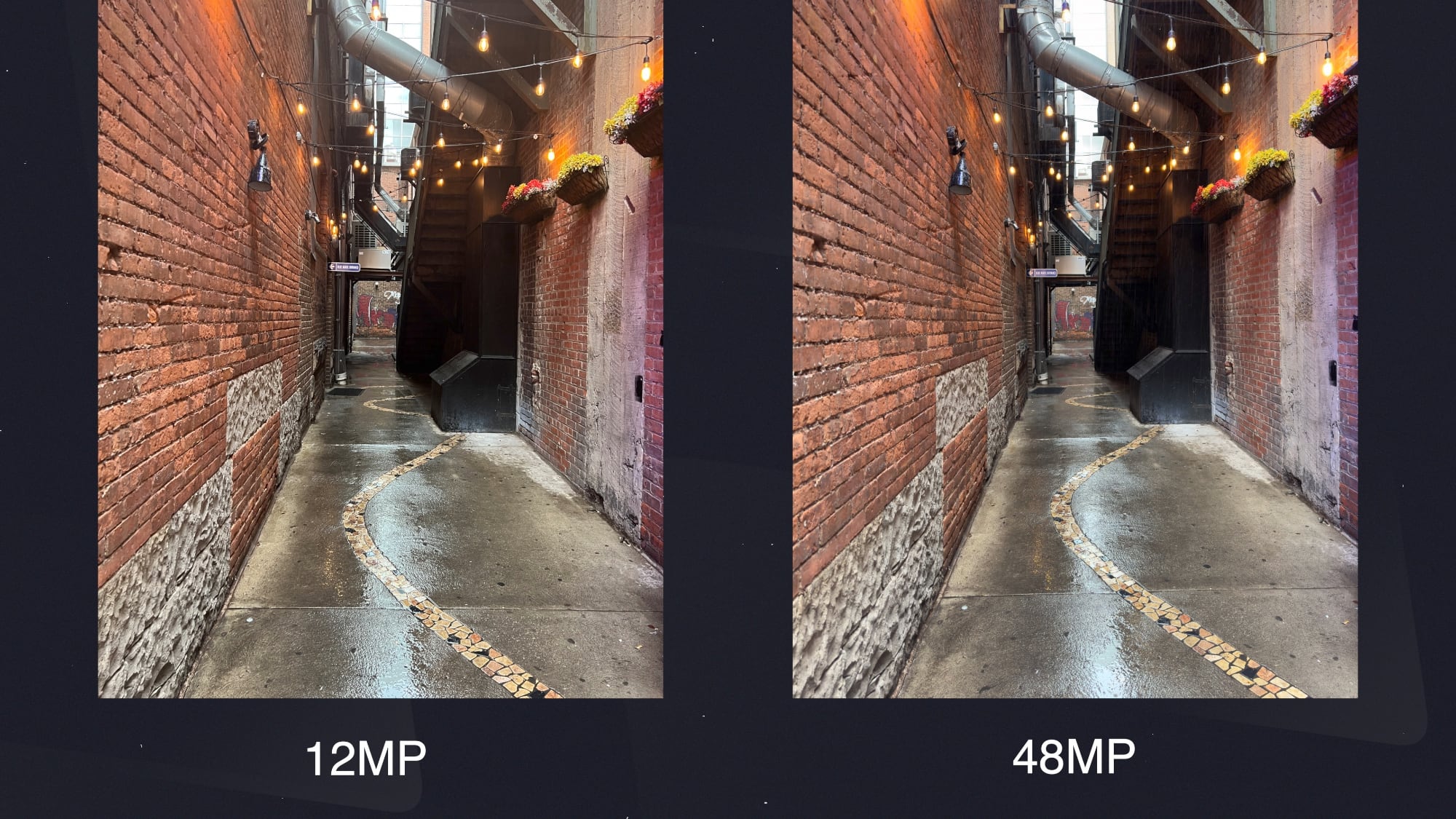
According to Apple, the Photonic Engine that is designed to enable Deep Fusion earlier in the computational photography process brings at least 2x improvement to all of the camera lenses, but it's hard to see that improvement in full in side by side Night Mode photos from the iPhone 14 Pro Max and iPhone 13 Pro Max.

There's less noise and less light reflection in the iPhone 14 Pro Max Night Mode photos, so there is a difference, but it's not night and day. Some of the iPhone 14 Pro Max photos can also look brighter, but there are no drastic upgrades here because the iPhone 13 Pro Max was already great.
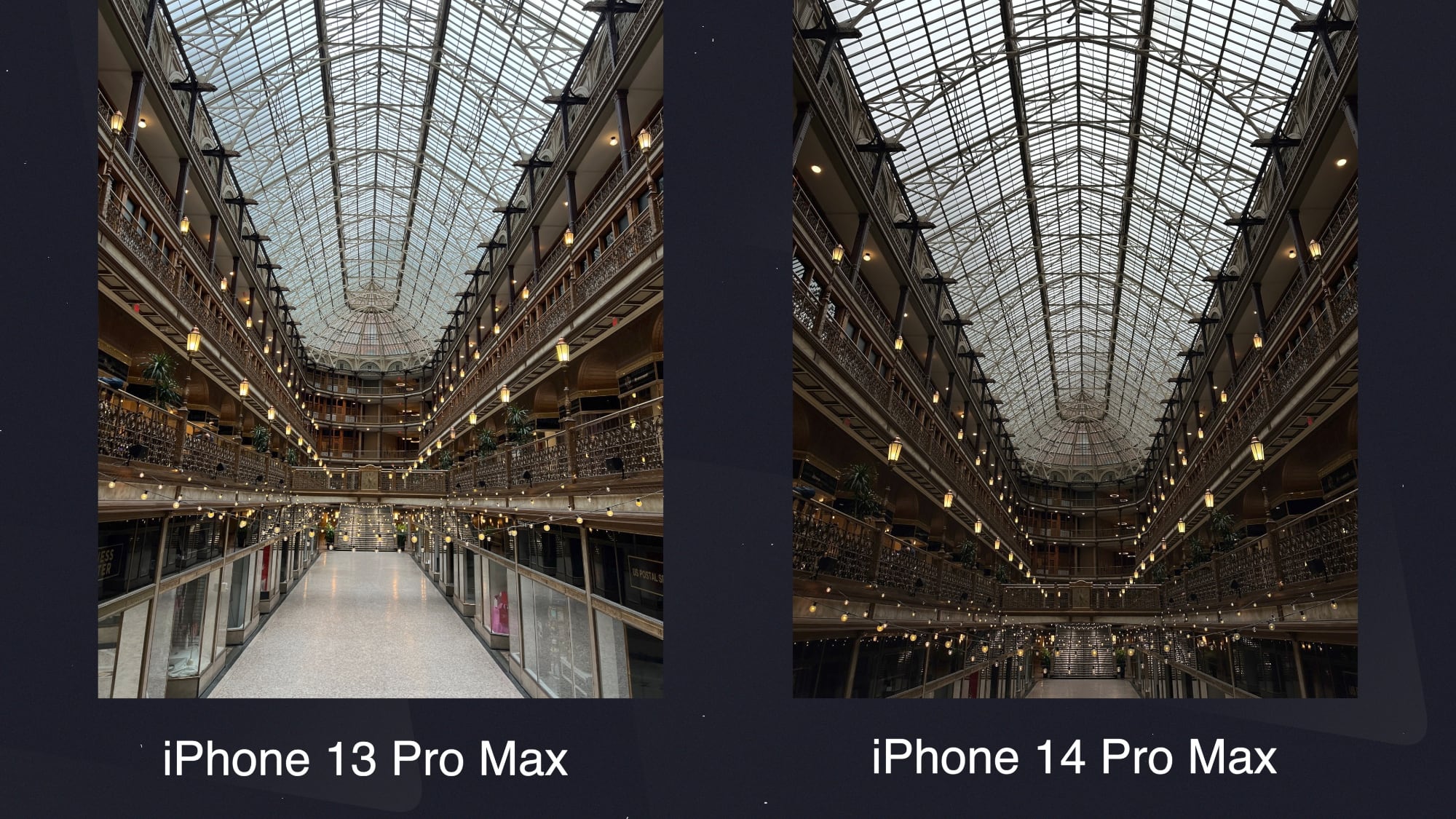
As for video, Apple added Action Mode, which is meant to mimic the stabilization you get with a gimbal, plus there are improvements to Cinematic Mode. Cinematic Mode now works in 4K at 24fps, up from the max 1080p resolution on the iPhone 13 Pro Max, so it's just more flexible for those who like to shoot in 4K.
Action Mode does indeed improve stabilization when you're shooting video while moving, so it's useful for filming a pet or a child while running, or taking action shots. Since it's limited to 2.8K resolution, you probably won't want to have it enabled at all times because it's a downgrade over 4K, but it's a solid feature if you need the extra stabilization. In many cases, you may not need the stabilization boost provided by Action Mode as the built-in default stabilization is good enough.
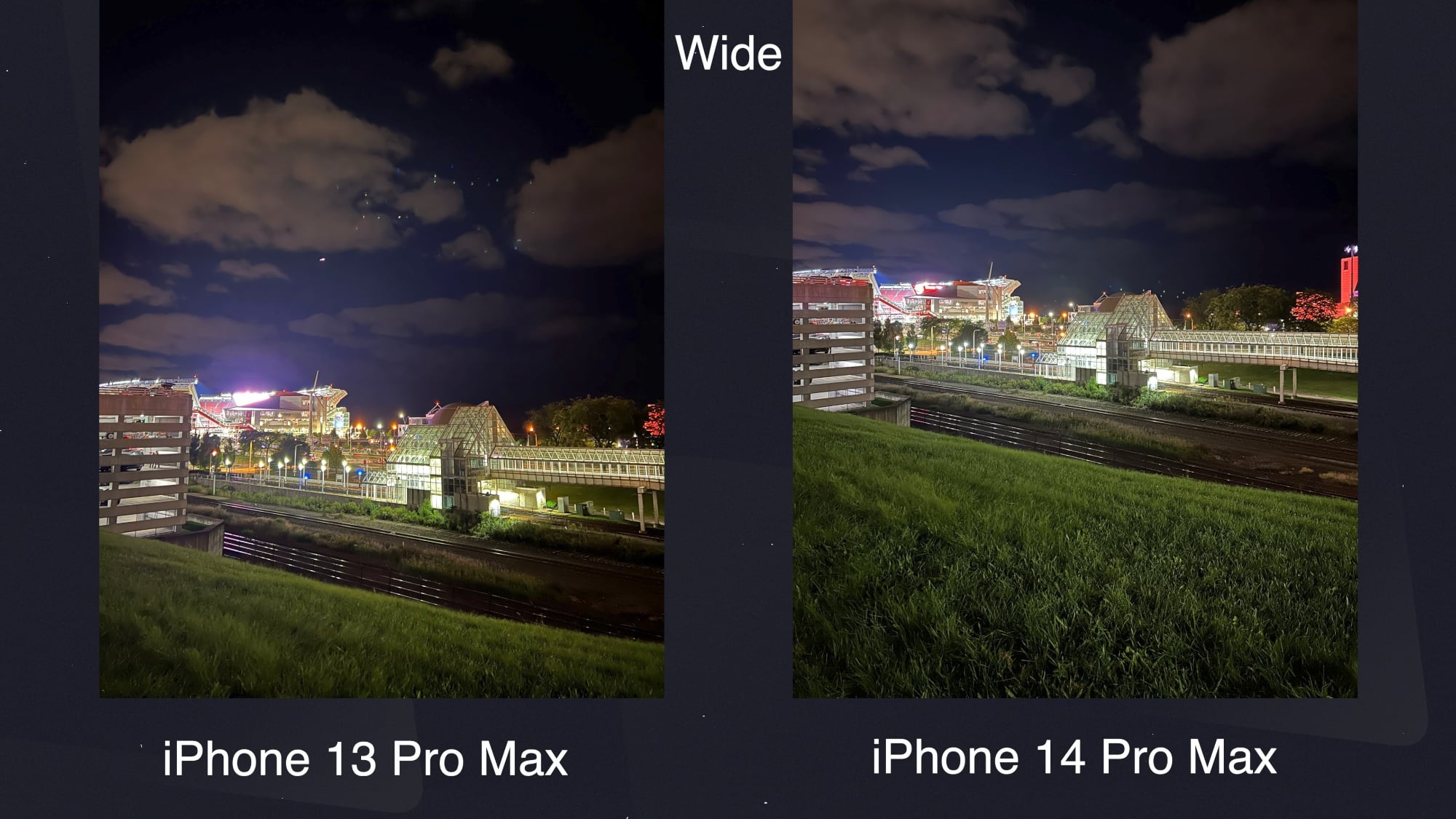
The iPhone 14 Pro Max cameras are a definite improvement over the iPhone 13 Pro Max cameras, but the new features for most people will only be used every now and then rather than on a daily basis. If you've already got an iPhone 13 Pro Max, it's probably not worth upgrading just for the camera alone, but there are of course other features to consider like Dynamic Island, always-on display technology, Emergency SOS via Satellite, and Crash Detection.
What do you think of the iPhone 14 Pro Max camera compared to the iPhone 13 Pro Max camera? Let us know in the comments below and make sure to watch the full video to see both smartphones in action.
Article Link: Camera Comparison: iPhone 14 Pro Max vs. iPhone 13 Pro Max
Agreed with some of the Comments that this review doesn’t really accurately explain the difference. I’m a full time pixel peeking photographer and have tried taking and actually editing a few raw images on my new 14 pro (had 13 pro before) and the difference is very noticeable. Not just the cropping abilities , but overall fidelity, color, accuracy and detail is better. I’m pretty impressed. My hope is that they give us an actually decent tele camera on the next. Ultra wide I don’t care about as much as distortion renders it meh.
They also appear significantly darker in the above (yes, I realize that is fixable but given how many photos I take it would be annoying to have to correct each one)
I always post-process correct (in Lightroom) for every photo I make (unless it's a casual throw-away snap); whether it's from a dSLR, mirrorless, or iPhone camera.
Definite improvements but with file size so large, will your average users ever use proRAW to receive the benefits of 48MP?
I think iPhone users who are into photography will. That's why I ordered my iPhone 14 PM with 512 GB.
I am on Verizon 5Guw service (ultra-wide band, probably using C-band and others).What issues were you having on the 13PM?
I can't imagine there being a big difference when I'm using a XS with a "crappy" Intel modem in Germany and getting 3-4 bars most of the time lol.
Maybe this is a US thing where cellular reception is spotty even in urban regions like NYC.
The 13 PM is superior to the 12 PM and has better coverage in areas where the 12 PM had insufficient signal. The 14 PM has that much better performance than the 13 PM: better signal strength, download speeds on the phone, but especially the download speed for tethering my laptop. The laptop download speeds through tethering is 150-250 Mbps.
I can get high speed 250 Mbps downloads on 2 bars. The bars don't seem to mean much with the 5Guw.
As phones advance in models, they have better signal acquiring ability in weak signal areas. What was a "spotty coverage" is now very good coverage from 13 PM to 14 PM. The battery life is much improved since the 3rd gen 5G modem is a much more power efficient process (Samsung 4nm).
In NYC there are many tall buildings and subways that interfere with signal quality. In crowded situations like conferences or sporting events, the later phones have much better reception.
https://www.anandtech.com/show/16481/qualcomm-announces-x65-x62-5g-modems
If you're pleased with your reception, then great. But in the US, we lack the population density (and tower density) of Europe, but even in major cities there are many signal barriers.
Last edited:
Register on MacRumors! This sidebar will go away, and you'll see fewer ads.


